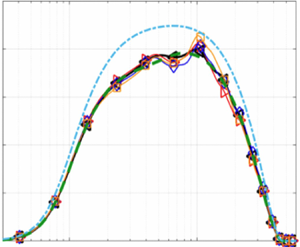Article contents
Assessing and improving the accuracy of synthetic turbulence generation
Published online by Cambridge University Press: 13 November 2020
Abstract

With the growing interest in scale-resolving simulations of spatially evolving boundary layers, synthetic turbulence generation (STG) has become a valuable tool for providing unsteady turbulent boundary conditions through a sum over a finite number of spatio-temporal Fourier modes with amplitude, direction and phase determined by a random number set. Recent developments of STG methods are designed to match target profiles for anisotropic and inhomogeneous Reynolds stresses. In this paper, it is shown that, for practical values of the number of modes, a given set of random numbers may produce Reynolds stress profiles that are 30 % off their target. To remedy this situation, the error in the STG stress prediction is decomposed into a steady-state bias and a purely unsteady part affecting the time convergence. Direct relationships between the random number vectors and both types of error are developed, allowing large collections of random number sets to be rapidly scanned and the best performers selected for a much improved agreement with the target. The process is verified for the inflow to a direct numerical simulation of a flat plate at  $Re_\theta = 1000$. This paper demonstrates sufficient time convergence over a few flow-through times as well as a correction of the method's biases.
$Re_\theta = 1000$. This paper demonstrates sufficient time convergence over a few flow-through times as well as a correction of the method's biases.
JFM classification
- Type
- JFM Rapids
- Information
- Copyright
- © The Author(s), 2020. Published by Cambridge University Press
References
REFERENCES
- 10
- Cited by



